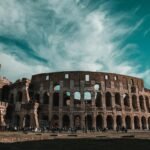Rome is one of those cities that captures your imagination even before you set foot there. Known as the Eternal City, it blends history, art, culture, and daily life in a way no other place does. For first-time visitors, exploring Rome can feel both exciting and overwhelming because everywhere you look, there’s something extraordinary to see. To help you plan your journey, here are ten must-see attractions that will make your first Roman holiday unforgettable.
The Colosseum
No trip to Rome is complete without visiting the Colosseum. This massive amphitheater, built almost two thousand years ago, is one of the most famous landmarks in the world. Once the stage for gladiator battles and grand public spectacles, the Colosseum is a living reminder of the power and ambition of the Roman Empire. Walking through its corridors and sitting in its stone seats, you can almost hear the echoes of the crowd cheering as gladiators fought for glory.
It’s best to book your tickets in advance to skip the long lines, especially during peak tourist season. Guided tours are also worth considering because they give you deeper insight into the history and construction of the monument. If time allows, explore the underground chambers, where gladiators and animals once waited before entering the arena.
The Roman Forum
Right next to the Colosseum lies the Roman Forum, the political, social, and commercial hub of ancient Rome. This site was once filled with temples, basilicas, and bustling marketplaces where Romans gathered for daily life. Today, it is a fascinating collection of ruins, with crumbling columns, arches, and stone pathways that whisper stories of emperors, senators, and ordinary citizens.
As you wander the Forum, it helps to imagine how it looked in its prime. The Temple of Saturn, the Arch of Titus, and the House of the Vestal Virgins are among the most notable remains. From the Forum, you can also climb Palatine Hill, where Rome was founded and where emperors later built their palaces. The hill offers sweeping views of the Forum and the Colosseum, making it a perfect place to reflect on the grandeur of Rome.
The Pantheon
The Pantheon is perhaps one of the best-preserved monuments from ancient Rome. Originally built as a temple to honor all gods, it has since been converted into a church. Its most striking feature is the enormous dome, which has inspired architects for centuries. At its center lies the oculus, a round opening that lets in natural light and connects the interior to the heavens.
Stepping inside, you are struck by the vast open space and the beauty of the marble floors and columns. The Pantheon also houses the tombs of several notable figures, including the artist Raphael. Unlike many other attractions, entry to the Pantheon is free, making it one of the most accessible yet unforgettable sites in Rome.
St. Peter’s Basilica
In Vatican City, just a short walk from the heart of Rome, stands St. Peter’s Basilica, one of the most important religious sites in the world. Whether you are religious or not, this basilica is awe-inspiring. Its immense size, stunning artwork, and spiritual significance draw millions of visitors each year.
Inside, you will find masterpieces like Michelangelo’s Pietà, a breathtaking sculpture that depicts Mary holding the body of Jesus. The grand dome, also designed by Michelangelo, dominates the skyline and can be climbed for a panoramic view of Vatican City and beyond. The climb is a bit challenging, but the view at the top is worth every step.
The Vatican Museums and the Sistine Chapel
The Vatican Museums hold one of the largest and most impressive art collections in the world. Walking through its galleries, you will see treasures collected by the popes over centuries, ranging from classical sculptures to Renaissance paintings. However, the highlight of the museums is undoubtedly the Sistine Chapel.
The Sistine Chapel is famous for its ceiling painted by Michelangelo, which depicts scenes from the Book of Genesis, including the iconic Creation of Adam. The sheer detail and beauty of the frescoes leave visitors in awe. Because the museums are vast, it’s wise to plan your visit ahead of time or join a guided tour to focus on the most significant pieces without feeling overwhelmed.
The Trevi Fountain
One of the most iconic fountains in the world, the Trevi Fountain is not just a stunning piece of Baroque art but also a symbol of good fortune. Tradition says that if you toss a coin into the fountain with your right hand over your left shoulder, you are guaranteed to return to Rome one day.
The fountain depicts Neptune, the god of the sea, surrounded by mythical figures and flowing water. Illuminated at night, the Trevi Fountain becomes even more enchanting, drawing crowds who gather to make their wishes. It’s a good idea to visit early in the morning or late at night if you want to enjoy the fountain with fewer people around.
Piazza Navona
Piazza Navona is one of the most beautiful squares in Rome and a great place to soak in the city’s vibrant atmosphere. Built on the site of an ancient Roman stadium, the square is surrounded by elegant Baroque buildings and filled with fountains, street artists, and lively cafes.
The centerpiece of the square is Bernini’s Fountain of the Four Rivers, which represents four major rivers of the world: the Nile, the Ganges, the Danube, and the Rio de la Plata. Around the piazza, you will also find churches, palaces, and plenty of places to sit down and enjoy a coffee or gelato while watching the world go by.
The Spanish Steps
The Spanish Steps are one of Rome’s most famous gathering spots. The wide staircase connects the Piazza di Spagna below with the Trinità dei Monti church above. Climbing the steps is a favorite activity for tourists and locals alike, and from the top, you get a lovely view of the city’s rooftops and streets.
At the base of the steps lies the Fontana della Barcaccia, a charming fountain shaped like a sinking boat, designed by Pietro Bernini and his son Gian Lorenzo Bernini. The Spanish Steps area is also known for its luxury shopping streets, such as Via Condotti, where high-end boutiques line the sidewalks.
Campo de’ Fiori
For a taste of Roman daily life, head to Campo de’ Fiori. By day, this square hosts a lively open-air market where vendors sell fresh produce, flowers, spices, and local specialties. It’s the perfect place to pick up picnic supplies or simply enjoy the colorful displays.
At night, the square transforms into a lively hub of bars and restaurants, attracting both tourists and locals. The statue of Giordano Bruno, a philosopher executed for his ideas, stands in the center as a reminder of the square’s historical significance. Campo de’ Fiori captures the spirit of Rome as a city that is always alive, whether under the sun or the stars.
Trastevere
Crossing the Tiber River takes you to Trastevere, a charming neighborhood known for its narrow cobblestone streets, ivy-covered buildings, and lively atmosphere. Unlike the grand monuments of central Rome, Trastevere offers a more intimate and authentic experience.
Here, you can wander aimlessly and discover hidden piazzas, small churches, and traditional trattorias serving delicious Roman cuisine. The Basilica of Santa Maria in Trastevere is a highlight, with its golden mosaics that shimmer in the light. In the evening, the neighborhood comes alive with locals enjoying dinner, music, and conversation, making it a perfect place to end your day in Rome.
Conclusion
Rome is a city full of history, beauty, and life. For a first visit, these ten places will give you a clear picture of what makes it so special. You will walk through ancient ruins, step inside famous churches, see world-known art, and enjoy lively streets and squares.
The best way to enjoy Rome is not to rush. Take time to sit in a piazza, enjoy a coffee, eat pasta in a small restaurant, or simply watch people passing by. These small moments are part of what makes the city unforgettable.
A first trip to Rome will always leave you wanting more. After seeing its highlights, most visitors find themselves planning to come back again one day.




